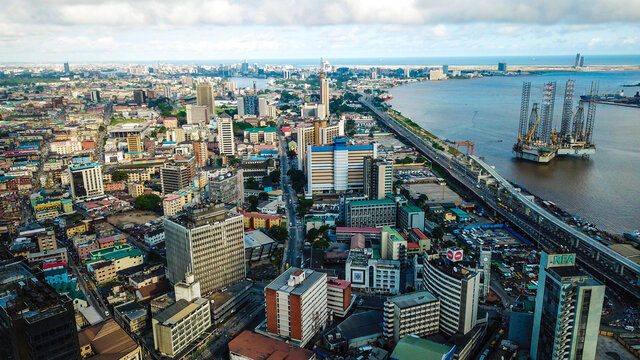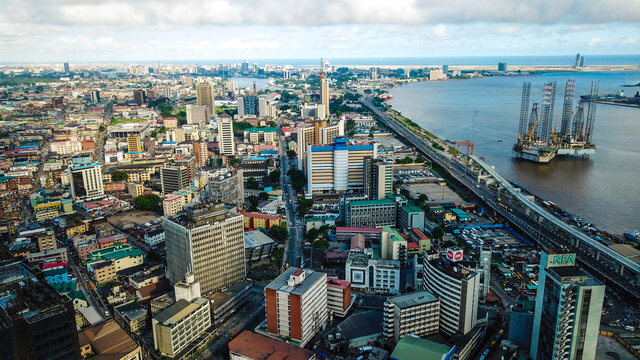Central bank of Nigeria through Bankers committee Consultants named as contractor begins N21 billion National Arts Theatre renovation project
About 28 years after it was abandoned, Nigeria’s primary centre for the performing arts – National Arts Theatre is now undergoing reconstruction, courtesy of the Central Bank of Nigeria (CBN) through the Bankers Committee.
The Guardian visit to the site in Iganmu, Lagos revealed that the building and civil engineering firm, Cappa & D’alberto Limited, has commenced preliminary work, which includes carting away debris removed from the building.
The proposed work on the facility includes modernising the design, ensuring general aesthetics, rehabilitating the lighting and cooling systems.
The initiative, it was gathered, would incorporate four major hubs; information and telecommunication, fashion and film as well as state of the art music facilities. There are also considerations to site hotels within the facility.
Specifically, the project coordinators have announced the selection of consultants. They include NAIRDA Limited, which will be in charge of mechanical, electrical and plumbing solutions to minimise waste while VACC Technical Limited, will provide parts of the building’s mechanical/electrical services.
Sources told The Guardian the renovation will not necessarily involve pulling down some parts of the iconic structure, but making the edifice a 21-century aesthetically compliant and a benefiting national asset, where young creative minds could converge when completed in 15-months.
The source revealed that the renovation will also centre on checking structural defects observed, which may not necessarily pose threat to the building itself.
The main bowl, which hasn’t been in use since 1993, would be renovated, adding that there would also be replacement of all the chairs, rehabilitation of the leaking roof. The curtains and acoustics are also going to change to modern ones.
The source said: “The consultants will work on the aesthetics to ensure they don’t just deliver a functional theatre but over that is aesthetically pleasing.
“We have a 350-capacity underground car park, nothing is wrong with it except to paint and mark. Although, it can’t serve everyone in a situation where the major hall sits 5,000; the least of the eight-halls sits is 580 people.
“The way the facility is structured is such that the entire environment could be used for a car park and so I still see that happening where people can maximally use the entire environment for a car park.”
However, the official revealed that a major shift is in Cinema Hall One, and Two. The Cinema Hall, it was disclosed, could be divided into two and make each conducive to house separate events and films.
“All over the world you see that there is nowhere people seat in 1,000 or 2,000 even when they have, there are still smaller halls that could be used for a fewer number of people. So the redesign intends to divide one of the Cinema Halls and most likely Cinema Hall Two to serve as a production and film area that would attract smaller audience.
“The structure is still intact and solid and I don’t see the contractor pulling down any of the structures. They are going to develop the fallow land and rebuild it as four hubs for fashion, ICT, music and film.
“The geo-technics have taken place on the fallow land during the COVID-19 lockdown and they must have considered certain things that need to be done regarding the water
About 28 years after it was abandoned, Nigeria’s primary centre for the performing arts – National Arts Theatre is now undergoing reconstruction, courtesy of the Central Bank of Nigeria (CBN) through the Bankers Committee.
The Guardian visit to the site in Iganmu, Lagos revealed that the building and civil engineering firm, Cappa & D’alberto Limited, has commenced preliminary work, which includes carting away debris removed from the building.
The proposed work on the facility includes modernising the design, ensuring general aesthetics, rehabilitating the lighting and cooling systems.
The initiative, it was gathered, would incorporate four major hubs; information and telecommunication, fashion and film as well as state of the art music facilities. There are also considerations to site hotels within the facility.
Specifically, the project coordinators have announced the selection of consultants. They include NAIRDA Limited, which will be in charge of mechanical, electrical and plumbing solutions to minimise waste while VACC Technical Limited, will provide parts of the building’s mechanical/electrical services.
Sources told The Guardian the renovation will not necessarily involve pulling down some parts of the iconic structure, but making the edifice a 21-century aesthetically compliant and a benefiting national asset, where young creative minds could converge when completed in 15-months.
The source revealed that the renovation will also centre on checking structural defects observed, which may not necessarily pose threat to the building itself.
The main bowl, which hasn’t been in use since 1993, would be renovated, adding that there would also be replacement of all the chairs, rehabilitation of the leaking roof. The curtains and acoustics are also going to change to modern ones.
The source said: “The consultants will work on the aesthetics to ensure they don’t just deliver a functional theatre but over that is aesthetically pleasing.
“We have a 350-capacity underground car park, nothing is wrong with it except to paint and mark. Although, it can’t serve everyone in a situation where the major hall sits 5,000; the least of the eight-halls sits is 580 people.
“The way the facility is structured is such that the entire environment could be used for a car park and so I still see that happening where people can maximally use the entire environment for a car park.”
However, the official revealed that a major shift is in Cinema Hall One, and Two. The Cinema Hall, it was disclosed, could be divided into two and make each conducive to house separate events and films.
“All over the world you see that there is nowhere people seat in 1,000 or 2,000 even when they have, there are still smaller halls that could be used for a fewer number of people. So the redesign intends to divide one of the Cinema Halls and most likely Cinema Hall Two to serve as a production and film area that would attract smaller audience.
“The structure is still intact and solid and I don’t see the contractor pulling down any of the structures. They are going to develop the fallow land and rebuild it as four hubs for fashion, ICT, music and film.
“The geo-technics have taken place on the fallow land during the COVID-19 lockdown and they must have considered certain things that need to be done regarding the waterlogged areas.
“Power would be a huge concern and certainly there would be a plan for alternative power as a major component, especially for an event centre.
The theatre was built during the military regime of former President Olusegun Obasanjo. Its exterior is shaped like a military hat and has a 5,000-seater Main Hall with a collapsible stage and two capacity cinema halls.
It was designed and constructed by a Bulgarian construction company in 1976 during the military regime and resembles the Palace of Culture and Sports in Varna, Bulgaria.
The theatre, which used to be a major attraction to Lagos, is about a half an hour drive from Lagos Island and is one of the best masterpieces of Nigeria before it became moribund due to neglect. The structure was the primary centre for the performing arts in Nigeria with a collection of the National Gallery of Modern Nigerian Art housed in a section of the building.
The Federal Executive Council had in February approved an agreement that would lead to its renovation. President Muhammadu Buhari had in 2020 given approval to the CBN and the Bankers Committee, to renovate the National Art Theatre and at the same time take over the adjourning lands to create a veritable creative industry, where there will be four hubs.
On completion, CBN is expected to manage the edifice for few years before handing it over to the government.
SOURCE: Guardian.ng

















